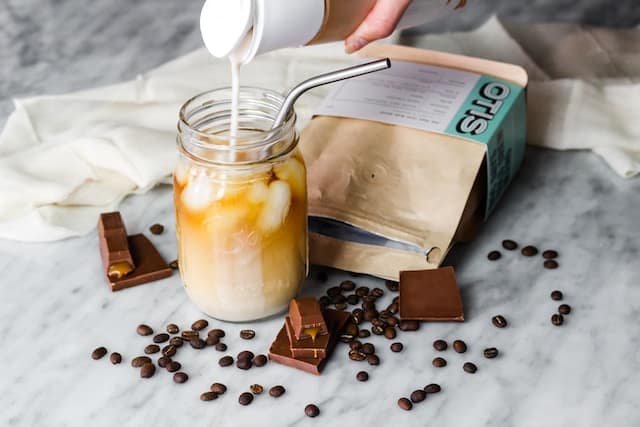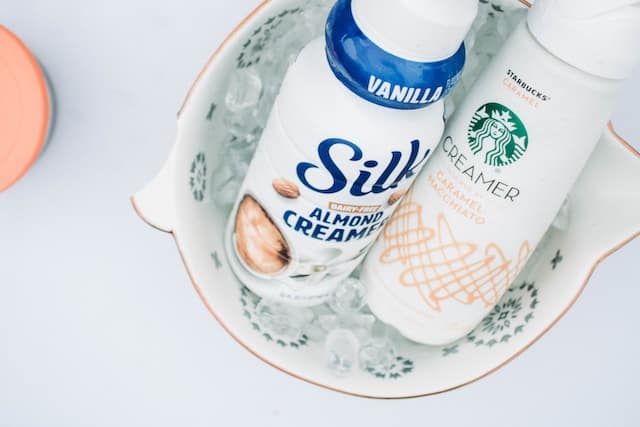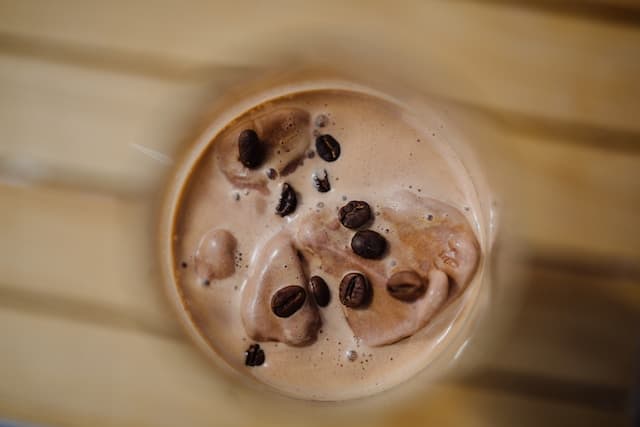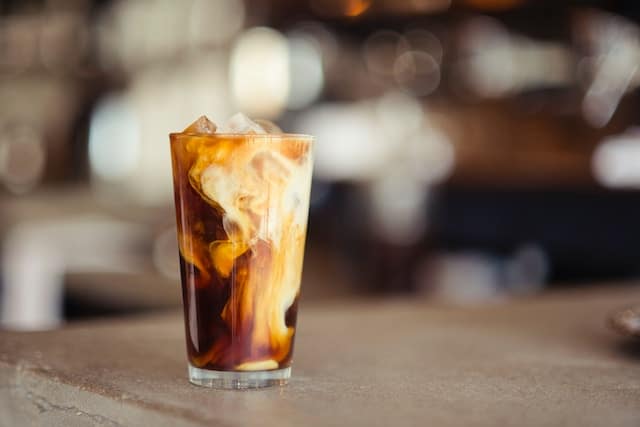Last updated on September 13th, 2023 by Jules Winnfield

If you’re like my wife, you drink your coffee with creamer. A lot of creamer.
One because she just can’t stand the taste of black coffee and two, she thoroughly enjoys the various flavors.
Creamer can be added to either an instant coffee or brewed.
But every so often she notices that her carton of creamer comes out chunky. Naturally, she is disgusted by it and throws out the whole thing.
But if you’re like me, you may ask why is my coffee creamer chunky in the first place?
So I got to digging and uncovered some fascinating pieces of intel that should be helpful.
Ok let’s dive in.
Where does coffee creamer come from?

Photo by Rozhita Rasouli
You can think of cream as fat. It’s the fat that is naturally found in cows milk. If you milk a cow and let the milk sit, you will notice that a layer of creamy fat forms on top.
Usually milk is pasteurized and then homogenized before showing up on market place shelves. Pasteurization is the process that kills nasty bacteria in the milk.
Homogenization, on the other hand, is the process that breaks down the creamy fats in the milk into smaller globules and evenly distributes it. This is why the milk you buy from the store looks white, tastes smooth and creamy and has a longer shelf life, with no fat layer on top.
Now let’s say you want some of that creamy fat.
There are a few main types:
- Heavy cream – the milk fat cream skimmed off the top of milk; usually 36% fat
- Half and half – equal parts whole milk and milk fat; usually 10-18% milk fat
- Creamers – made of various concentrations of milk fat cream, milk, sugar and flavorings
What is coffee creamer?

Photo by Elana Selvig
Creamers are products that package this milk fat separately in various ways. There are ton of different variations like no sugar and fat free. Some of the most popular are:
- Nondairy creamers – Usually made using water, oil, and sugars
- Plant based creamers – made with oat, almond, soy milks, etc.
- Dairy creamers – made with natural milk cream fat, milk and sugar. Chobani has a line that’s pretty good.
Creamers can also come in liquid or powder. The only difference is the shelf life: powder lasts longer than liquid. Liquid has to be stored in the fridge and powder can sit out at room temperature.
Why is my coffee creamer chunky?

Photo by Phil Hearing
Coffee creamers contain a protein called casein. It’s the main protein component in milk and has metabolic function. For example, its why babies need milk to gain weight.
Casein along with other proteins are stable in normal situations. But if you add something acidic to it, this breaks down the stability and the proteins start to clump together. Hence the curdling. This coagulation is ok when you see it in cheese but not so appetizing otherwise.
There’s a few reasons why your coffee creamer may be chunky.
1. Its expired
Like most dairy products, there is an expiration date on perishable foods like coffee creamer. If its past the expiration date, then the chunkiness could mean its gone bad. In that case, you want to toss it. Let’s not play around with dairy. It can make you sick if you’re not careful.
Be sure to check the expiration date, and the smell and taste for signs of rancidness before pouring away.
My wife has a bad habit of forgetting to put the coffee creamer back in the fridge after using it. So when her creamer is chunky, its usually for this reason.
2. Acidity
As we mentioned earlier, an acidic environment or decrease in pH will cause the proteins in milk to aggregate and clump together.
Let’s also remember that coffee is an acidic beverage. Depending on the roast of your coffee beans, grind, and brewing method, your coffee can be more or less acidic. So when you pour your coffee creamer into your coffee, you may find floating chunks.
To taper down the acidity of your coffee, consider:
- Using a dark roast: Dark roast tend to have more of the acidity removed and thus less acidic
- Adding eggshells into your brew: we’ve talked about this before, but eggshells are alkaline in nature, so it makes for a good acid reversal option
- Cold brew coffee: because of the way its brewed, there tends to be less of the coffee acids in cold brew
- Adjusting your brew method: by increasing the brew time and brewing at a lower temp, you get all the acidic compounds as well as the alkaline compounds that tend to extract later
- Adding a bit of salt, which can cut through the acid
3. Water
The water you use could also cause chunky creamer in your coffee. The reason is once again related to acidity. If you don’t filter your water (which I recommend you do for the best tasting coffee), there can be impurities and contaminants that decrease the pH and increase the chance of coffee creamer curdling.
Consider using pH strips to make sure your water is alkaline and pure.
4. Temperature
If the temperature of your coffee is too hot or cold, the large difference in temperature of your coffee creamer can also shock the proteins and cause clumping. To fix this consider:
- Warming up your coffee creamer a bit before adding to your coffee
- For iced coffee beverages, mix powdered coffee creamer in warm water separately before adding to your coffee and ice
- Let your coffee sit for a few minutes before adding the creamer. If you run around the house in the morning getting ready for school or work while your coffee brews, then this solution is already built into your routine!
5. Type and Storage
The other issue causing creamer curdling and chunkiness could be improper storage. Depending on the creamer type and its ingredients, if it’s not stored properly then the creamer can curdle more easily.
For example, some creamers should not be refrigerated. Check the packaging to be sure.
In addition, certain creamer types are more likely to be chunky from the changes to their protein content. Plant based creamers, for example tend to clump more easily than your non dairy creamer types.
Final Thoughts

Photo by Demi DeHerrera
Overall, coffee creamers come in various types and variations. From super fatty heavy cream, whole milk, to natural and non dairy creamers, there are a ton of options to create delicious smooth rich coffee flavors.
But coffee creamer can get chunky and curdle under various conditions. Ultimately, if the creamer hasn’t gone bad and expired, then the chunkiness is really a personal preference. My wife doesn’t really like it. But personally I don’t mind it.
If you don’t like it, then consider experimenting with different creamers, plant based, powered, liquid, half and half or even just milk until you find what works best for you.
Also experiment with your brew types (drip coffee, espresso, cold brew) and brewing methods (acidity, temperature) to find the ideal brewing conditions for you.
FAQs
Which is better coffee creamer or milk?
Milk will give your coffee a smooth balanced taste. Coffee creamer is sweeter and comes with more flavor varieties.
So in terms of flavor, creamer is probably better for giving your coffee a delicious creamy feel. But if you want the maximum health benefits from drinking coffee, milk is probably the better option.
Not only does coffee creamer have more sugar, but one study found that the beneficial compounds in coffee like chlorogenic acid were less absorbed in coffee with coffee creamer added. Milk on the other hand had no effect on absorption.
Coffee Has Never Read This Good!
Sign up for a FREE newsletter to the best home brewing tips and guides
Thank you for subscribing to The Cup Coffee House Crew! There's a surprise in your Inbox 🙂
Something went wrong.
- About the Author
- Latest Posts

“Jules” is a pharmacist by day and investor, writer, and health nut by night. When he’s not sipping on some coffee laced with MCT oil during an 18 hour fast, he is writing about how to get your coffee grind on or playing Monopoly with his 2 boys and wife. Ahh…life is good!
